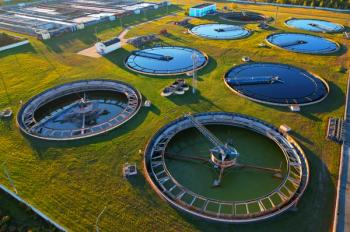
The LCGC Blog: Large Molecule Analysis for Small Molecule People
In 2009 I wrote an article on the emerging field “Bio Chromatography,” which for a small molecule analyst such as myself, perfectly described the situation. I realize that the separation of biomolecules had been happening for many years, but the expansion and development of protein based therapeutics from that point onwards has seen an avalanche of developments in instrumentation, sample preparation, and column technologies the like of which I have not seen in my 30 year career.
In 2009 I wrote an article on the emerging field “Bio Chromatography,” which for a small molecule analyst such as myself, perfectly described the situation. I realize that the separation of biomolecules had been happening for many years, but the expansion and development of protein based therapeutics from that point onwards has seen an avalanche of developments in instrumentation, sample preparation, and column technologies the like of which I have not seen in my 30 year career.
I speak with many “small molecule” folks who are moving into biomolecule analysis and are dismayed at the heterogeneity of proteins and the variety of techniques required to characterize them. My work since 2009 has taught me to take a high level view on the subject and cut through the more esoteric and specialized applications in order to focus on what is more routine in biomolecule characterization.
For those of you faced with moving into this type of analysis or just for interest, what follows is my guide to the characterization of protein biologics, as exemplified by a typical monoclonal antibody (mAb) therapeutic agent, which are proteins made from a single cell line which can be used to block cell division, trigger the immune system to kill cancer cells, or deliver small molecule therapies to cancer cells. This year, more than half of the top 10 selling drugs will be monoclonal antibodies or their derivatives with over 700 generics (biosimilars or biobetters) in development.
The complex nature of these molecules means that several different techniques need to be used to characterize them and their many heterogeneities (Figure 1). Often, the protein needs to be broken down in specific ways using sample preparation techniques in order to achieve the required analytical outcomes.
Figure 1: Major structural details of a typical monoclonal antibody.
Reversed-Phase Liquid Chromatography (RP-HPLC)
Reversed-phase chromatography can be used to study intact as well as cleaved proteins to gain information on purity and identify variants whose hydrophobicity differs. Differences in hydrophobicity occur as a result of post-translational modifications, which are enzyme induced, covalent changes that occur during or after biosynthesis.
Variants typically appear as small peaks eluting either before or after the main peak and need to be characterized in order to relate the type of modification to the retention time for on-going monitoring and toxicity assessment. Dithiothreitol and papain can be used to cleave the proteins into smaller subunits (light and heavy chains of a monoclonal antibody, for example) so that the variability can be associated with particular regions of the protein (Figure 2).
Figure 2: Cleavage of various regions of monoclonal antibody to facilitate characterization.
Due to the size and slow diffusion characteristics of bio-molecules, several tactics need to be employed in order to avoid poor reversed-phase chromatography and these include:
- The use of highly deactivated phases combined with ion pair reagents (TFA remains the most prolific) to prevent poor peak shape due to secondary interactions with the stationary phase support
- The use of highly efficient particles with wide pores (300 Å is typical) and increased temperature to mitigate peak broadening due to slow diffusion kinetics
- Utilizing less hydrophobic stationary phases (C4 is typical) in combination with stronger elution solvents and higher temperatures to avoid long retention times
One needs to be vigilant to any artificial changes to the structure or chemistry of the analyte induced by increased temperature or pressure during the chromatographic process.
Reversed-phase chromatography coupled with mass spectrometric detection can provide more specific information on post-translational modifications (for example deamidation of an asparagine residue) or subtle changes in the make-up of the glycan (polysaccharide residue), which is critical for the efficacy of most proteins. One needs to consider the effect of ion pairing reagents on the MS signal as TFA may suppress the signal and alternative ion pairing reagents may need to be employed.
While reversed-phase analysis of the intact or partially fragmented protein is useful, it does not provide information on localized modifications. Typically the protein will be digested using a chaotropic reagent such as trypsin and reversed-phase chromatography with MS detection used to characterize the type and specific site of any modifications from the resulting peptides. This is particularly useful as post-translational modifications at critical positions on the protein may radically change the efficacy or safety of the protein.
HPLC–MS can also be used to compare the retention time, mass and area of the peptide peaks from digested proteins with in-silico prediction models, to sequence the peptides, allowing protein identification. Typically the degree to which the in-silico model fits the experimental data is called “sequence coverage,” and the higher the coverage, the more confidence we can have with the identification. High efficiency stationary phases using sub-2 μm and core-shell particles are very useful in protein sequencing as higher peak capacities increases the number of individual peptides which can be separated and identified, improving sequence coverage and protein identification.
Hydrophilic Interaction Chromatography (HILIC)
HILIC techniques are often used to characterize the N-linked glycan moieties of glycoproteins. These polysaccharide species are very important in determining protein folding and function and are complex, containing many monosaccharides, combined in core and antennary structures. The number, type, and arrangement of the monosaccharides within the glycan will affect the form and efficacy of the protein and many commercially successful antibody protein drugs contain N-linked glycans.
Typically the glycan will be enzymatically cleaved from the protein (typically using PNGase F) and then labeled with a fluorophore, of which 2-aminobenzamide (2-AB) is the most popular (Figure 3). The tagging is necessary due to the lack of a UV chromophore and facilitates fluorescence detection, however MS detection and structural characterization of the glycan moieties is now very popular.
HILIC techniques are necessary as the glycan units are highly polar and poorly retained or separated under reversed-phase conditions. Acetonitrile gradients from 90-60% at pH 4.5 are typical and high efficiency particle morphologies combined with bonded polar phases are capable of separating the many possible glycan forms which is necessary in order to fully characterize the protein glycoforms and any impurities and variants. Often the difference between an originator protein and a biobetter may lie primarily in the structure of the N-linked glycan.
Ion-Exchange Chromatography (IEX)
Ion-exchange chromatography (IEX) has been widely used in the analysis of biomolecules and remains one of the gold standard strategies for charge variant analysis.
The most common causes of charge variants are deamidation, isomerisation, succinimide formation, oxidation, silylation, N-terminal pyroglutamic acid, or C-terminal lysine clipping. IEX separates compounds based on the electrostatic interaction of the ionic groups on the protein surface or the monoclonal antibody and the oppositely charged ionic group on the surface of the stationary phase. Cation-exchange columns have a negatively charged surface-these columns are used at pH values below the isoelectric point (pI, the pH at which the protein charges are balanced and the net surface charge is 0) of the peptide or protein.
Conversely, anion-exchange columns have a positively charged stationary phase and are operated above the peptide or protein pI. The selection of stationary phase and mobile phase pH strongly depends on the species being analyzed. The conditions have to be selected such that the protein and the stationary phase are in their charged forms.
IEX is of interest for the analysis of biomolecules as the separation is performed under non-denaturing conditions, unlike RP HPLC. Elution of compounds in IEX is achieved via a salt or pH gradient to interrupt the compound/stationary phase interactions.
Comparison of the elution order for salt and pH gradient experiments show that the mAb compounds elute in a similar order under both sets of conditions with variations seen for only a few mAbs (1,2). The peak capacity (resolving power) for each method has also been calculated and was found to be higher under salt gradient conditions.
Cation-exchange chromatography is particularly suited to the analysis of mAbs due to their basic nature. It has been shown that cation IEX can be used to identify post-translation modifications such as aspartate isomerisation, asparagine deamidation, oxidation, and fragmentation etc. (3).
Size-Exclusion Chromatography (SEC)
Size-exclusion chromatography is used for separating and quantifying protein mixtures. This includes measuring aggregates (dimers, trimers, tetramers, etc.), separating low molecular weight excipients and impurities from the larger molecular weight proteins, and determining changes to the molecule such as clipping and other post translational modifications.
It is important to understand and be able to control aggregation in biomolecules as it will affect their efficacy, lifetime, and can produce an immunological response. In size-exclusion chromatography (SEC) there is no interaction between the analyte and the surface and separation is primarily by means of the degree of inclusion or exclusion from the pores within the stationary phase. The pores have different accessibility for molecules of different sizes (hydrodynamic volume), for example, large molecules are poorly retained and elute first as they cannot access the pores within the stationary phase, whereas smaller molecules will diffuse into the pores to a greater extent depending on their size and will be eluted later, with the smallest molecules eluting last. The “size” of the biomolecule can depend upon the molecular weight, degree of folding, and degree of hydration.
There are several factors which should be considered when selecting columns and conditions for SEC:
- The stationary phase should be as insert as possible and silica based columns should be bonded with diol or a polymeric phase to prevent unwanted secondary interactions
- The pore size of the SEC column should be selected to reflect the molecular weight (MW) range of the proteins being analyzed
- Due to the fact that all compounds elute before the column dead time (t0), SEC columns often have large internal diameters (~7 mm) and are relatively long (25–30 cm)
- Mobile phase flow rates are relatively low (0.5 mL/min) which generates a comparatively large t0
- Mobile phase components should not interact with the solute proteins
- For proteins a phosphate buffer with pH 7 is often selected as this is close to the pI of most proteins (it can also be considered as the buffer which most closely resembles physiological conditions)
- Interactions between analytes and the column can be decreased by adjusting the salt concentration-at high salt concentration interaction between proteins and the stationary phase will be minimized
Separations may require optimization to provide improved resolution, maintain protein solubility, or to decrease sample interaction with the chromatographic media. This can be done by optimising several parameters, including mobile phase ionic strength, pH, use of organic solvents, and temperature.
Typically, SEC separations are carried out at 20–30 °C, however, separation of proteins and peptides may require higher temperatures to improve resolution and recovery. It should be noted that increases in pressure and temperature can lead to an increase in aggregation on the column which can result in errors in quantitation.
So there we have it-a whistle stop, and very basic, tour of the chromatographic techniques typically used for protein characterization. I’m aware that I haven’t included any chromatograms, however I will be producing a review, which will be published shortly, and will include further specific details of chromatographic conditions and typical chromatograms, should you have a need to practically implement any of the techniques discussed above.
References
- S. Fekete, A. Beck, J. Fekete, and D. Guillarme, J. Pharm. Biomed. Anal. 102, 33–34 (2015).
- S. Fekete, A. Beck, J. Fekete, and D. Guillarme, J. Pharm. Biomed. Anal. 102, 282–289 (2015).
- K. Sandra, I. Vandenheede, and P. Sandra, J. Chromatogr. A, 1422, 27–33 (2013).
Tony Taylor is the technical director of
Newsletter
Join the global community of analytical scientists who trust LCGC for insights on the latest techniques, trends, and expert solutions in chromatography.





